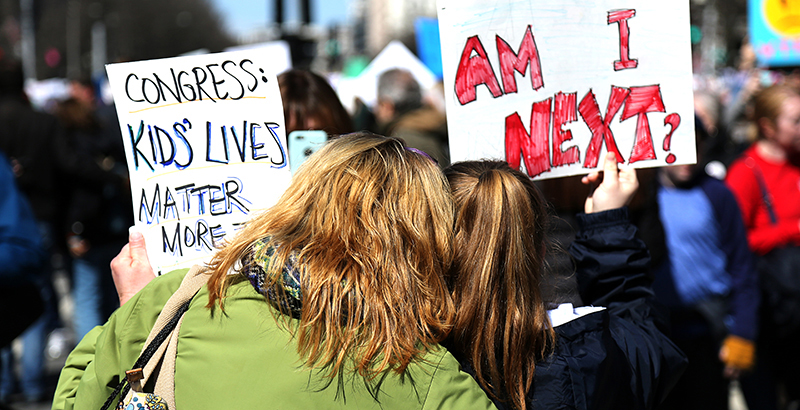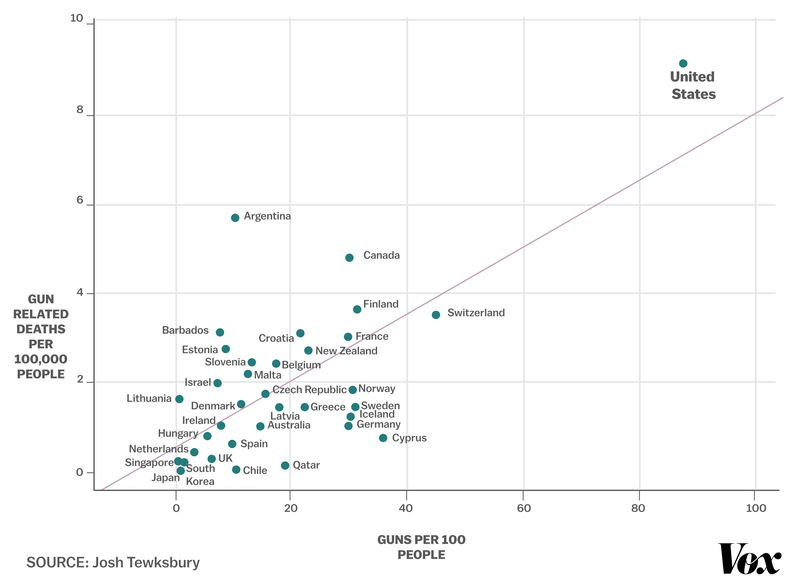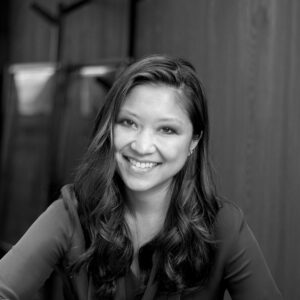The View From Inside Saturday’s March For Our Lives: Students Demand a Revolution in Gun Control — and Lead a Deafening Moment of Silence — in Washington, D.C.

See our complete coverage of Saturday’s March For Our Lives:
—Video exclusive: The students we met marching for their lives
—Portraits of protest: Photos from the streets of the nation’s capital
—#MarchForOurLives: 51 memorable images from a social media spectacle
—One-on-One: 14 students talk about why they’re marching
—Analysis: Old enough to march, old enough to vote?
—A student’s voice: Why I’m marching this weekend
For nearly six minutes Saturday, school shooting survivor Emma Gonzalez stood at a podium in front of almost 1 million people, on national television, and said nothing.
It was a remarkable and chilling silence — one that rang louder than the star-studded musical performances that took the stage in Washington, D.C., before Gonzalez got up to speak.
“Six minutes and about 20 seconds. In a little over six minutes, 17 of our friends were taken from us.” said Gonzalez, a senior at Marjory Stoneman Douglas High School, as she opened her speech at March for Our Lives. She then named all the victims who died in the Parkland, Florida, school massacre last month, and promptly began her long moment of silence.
Gonzalez’s statement was just one of many hauntingly poignant moments that tore open hearts and moved ralliers to tears. Stoneman Douglas student Aalayah Eastmond transported marchers to her classroom on Feb. 14. She was studying Holocaust history when bullets started flying in — her classroom was the gunman’s third. Samantha Fuentes, who was shot in both legs that day and had shrapnel behind her eye, led a million-person rendition of “Happy Birthday” for fallen classmate Nicholas Dworet that thundered down Pennsylvania Avenue. Dworet would have turned 18 on Saturday.
“I am here for you,” Fuentes told ralliers. “So you don’t ever have to fear of getting shot in your own classroom, you don’t ever have to wonder if you’ll have to see your best friend die next to you, you don’t ever have to worry about going into a Holocaust history class to learn about death and then experience it right before your eyes.”
The estimated 800,000 protesters who packed a three-quarter-mile section of Pennsylvania Avenue between Capitol Hill and the White House made March for Our Lives, a colossal effort led by Stoneman Douglas students to advocate for gun-control legislation, one of the biggest youth protests in the U.S. since the Vietnam War era — and the largest single-day demonstration in Washington history. Over 800 sister rallies were held across the country and around the world. From Paris to Tokyo, millions of global citizens showed up Saturday to support the cause.
“It’s not about race. It is not about your sex. It is not about ethnicity. It is not about gender. It is not about how much money you make, What it comes down to is life or death,” Stoneman Douglas survivor Alex Wind said. “To all the politicians out there, if you take money from the NRA, you have chosen death. If you have not expressed to your constituencies a public stance on this issue, you have chosen death. If you do not stand with us by saying we need to pass common-sense gun legislation, you have chosen death. And none of the millions of people marching in this country today will stop until they see those against us out of office. Because we choose life.”
Rates of gun violence are higher in the United States than in any other developed country. The gun homicide rate in America is nearly six times that of Canada, seven times that of of Sweden, and almost 16 times that of Germany. More than 187,000 students in at least 193 K-12 schools have experienced a campus shooting since the Columbine massacre in 1999, according to a Washington Post analysis. The report found an average of 10 school shootings a year in that same time. There have been 11 school shootings in the first three months of 2018 alone, putting this year on track to be one of the worst in history.

New Jersey student Matan Ackelsberg traveled to the nation’s capital Saturday because he is tired of those statistics: Too many Americans are dying from gun violence, he said, and he wants to see change.
“I’m always a little bit scared that it’s going to happen in my school,” Ackelsberg told The 74. “Going into high school… I had to think to myself if I could get through those four years without something scary happening. It’s always been in the back of my head. I realized that that was a thing I shouldn’t be thinking — I shouldn’t be thinking, ‘OK, I’ve got two years left.’ That shouldn’t be a thing I have to worry about. That shouldn’t be a thing that anyone has to worry about.”
The D.C. stage was set in the shadow of the Capitol building, and the march’s route passed beneath the First Amendment inscription on the Newseum’s facade: “Congress shall make no law respecting an establishment of religion, or prohibiting the free exercise thereof; or abridging the freedom of speech, or of the press; or the right of the people peaceably to assemble, and to petition the Government for a redress of grievances.”
A fitting backdrop for Saturday’s #MarchForOurLives #firstamendment pic.twitter.com/okrx1Vkf8X
— Emmeline Zhao (@emmelinez) March 25, 2018
Throughout Saturday’s assembly, America’s young people echoed two major messages for the country’s lawmakers and politicians: First, this rallying cry for stricter gun laws is a movement, not a moment. Second, take action toward arms control, or we will wield a weapon mightier than the gun: the right to vote.
“Stand for us, or beware: The voters are coming,” 11th-grader and Stoneman Douglas survivor Cameron Kasky declared. “Welcome to the revolution. It is a powerful and peaceful one, because it is of, by, and for the young people of this country…. We hereby promise to fix the broken system we’ve been forced into and create a better world for the generations to come. Don’t worry, we’ve got this.”
As the program continued for nearly three hours, “vote them out” chants rippled through the crowd.
Stoneman Douglas survivors weren’t the only students to address lawmakers and voters. Young adults from across the country who have lost loved ones to gun violence — including students from Los Angeles, New York, and Chicago — issued the same calls to action.
Even 11-year-old Naomi Wadler, representing the “African-American girls whose stories don’t make the front page of every national newspaper,” was ready to fight with her right to vote. The fifth-grader from Alexandria, Virginia, was asked to speak at the rally after organizing a walkout at her school to protest gun violence.
“My friends and I might still be 11, and we might still be in elementary school, but we know — we know life isn’t equal for everyone and we know what is right and wrong,” Wadler said. “We also know that we stand in the shadow of the Capitol, and we know that we have seven short years until we, too, have the right to vote.”
The students who spoke Saturday came armed — with policies they want to see enacted. Among them: prohibition of high-capacity magazines, a ban on assault weapons, and closing of loopholes for gun purchases. Instead of funding security measures and armed officers for schools, they said, the money to go toward teachers, instructional materials, mentorship programs, mental health resources, and paid internship and job opportunities. Washington, D.C. student Zion Kelly has already submitted a request to the City Council to expand public safety zones that could have prevented the fatal shooting of his brother last year.
Edna Chavez, a high school student from south Los Angeles, lost her brother to an act of gun violence in 2007 — he was shot outside their home.
“If the bullet did not kill me, that anxiety and that trauma will. I carry that trauma everywhere I go. I carry it with me in schools, in class, walking home, and visiting loved ones, and I am not alone in this experience,” Chavez said. “For decades, my community of south Los Angeles has become accustomed to this violence…. This is normal — normal to the point that I learned to duck from bullets before I learned how to read.”
Chavez criticized her school district for having a police department that profiles and criminalizes black and brown students. Instead, she said, the district should house a department specializing in restorative justice.
“Policymakers, listen up. Arming teachers will not work. More security in our schools does not work. Zero-tolerance policies do not work. They make us feel like criminals,” she said. “We should feel empowered and supported in our schools.”
A little over a half-century ago, another cry for empowerment similarly came from the shadows of the Capitol building. During the March on Washington for Jobs and Freedom in 1963, Martin Luther King Jr. told America that he had a dream.
“My grandfather had a dream that his four little children would not be judged by the color of their skin, but the content of their character,” 9-year-old Yolanda Renee King declared Saturday, in a surprise appearance. “I have a dream that enough is enough and this should be a gun-free world, period.”
She continued on to lead a cheer to instill the promise and empowerment of her generation.
Repeat After Me “Spread the word! Have you heard? All across the nation…WE are going to be a great generation!” #KidsVoice #StuVoice Yolanda Renee King #MarchForOurLives pic.twitter.com/PtgxLDckhE
— Dr. Alice Wilder (@alicewilder) March 24, 2018
That proclamation headlined what some see as a new youth movement, ushering in an era of political activism that parallels the causes of the 1960s.
“Love will always outweigh the hate, as the universe is on the side of justice,” Stoneman Douglas survivor Jaclyn Corin said. “So I need each and every one of you, no matter your age, to continue to fight alongside us. Because hearts cannot pump without blood and I don’t want your community to join the ghastly inner circle that mine is now a part of. In the end, we are all fighting for our lives, but we are a great generation and we’ll be the ones to make America safe.”
Get stories like these delivered straight to your inbox. Sign up for The 74 Newsletter

;)
